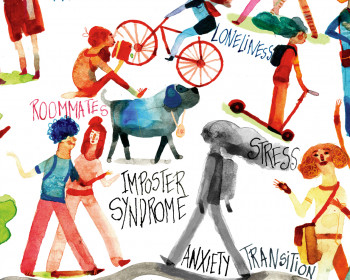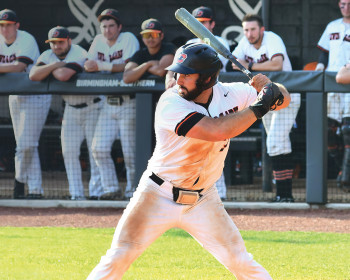A Diabetes Advocate Has Her Day
Open gallery

On November 14, 2007, the United Nations will observe the first annual U.N. World Diabetes Day, as established last year by U.N. Resolution A/61/225. People living with diabetes all over the world have Clare Rosenfeld CAS ’08 to thank for that.
by Ellisa Valo
Clare Rosenfeld was 71⁄2 years old when she gave her first speech on diabetes. As she stood before the postal workers who had gathered to hear her talk at the local post office, she recalls, “I was terrified. I was just this little kid, surrounded by all these gigantic grownups.” One man in particular made her nervous. “He was huge, and really intimidating.” But Clare mustered her courage and explained to the group what it was like to live with diabetes–the constant blood sugar monitoring, the daily insulin injections, the frustrating food restrictions.
At the end of her speech, Clare brought out a needle to demonstrate how she tested her blood sugar six times a day. Pricking her finger, she drew a tiny bead of blood.
The huge, intimidating man fainted.
“That was a big moment for me,” says Clare. Here she was, just a tiny little girl with a chronic disease, but at that moment, she realized she had the power to make an impact on people. She felt strong.
Early Activism
Clare’s life as a diabetes activist started the moment she was diagnosed with type 1 diabetes at age 7. Hospitalized to gain control over her symptoms, Clare was told only that she had a disease that was not going away. “My only prior experience with anything like that was my grandfather’s struggle with cancer,” Clare recalls. “So for a full week, I didn’t know whether I was going to live or die, or to spend the rest of my life in the hospital. No one really thought to explain the disease to a 7-year-old.”
Toward the end of her hospital stay, a young girl named Anne–not much older than Clare–walked into her room. “She changed everything for me,” says Clare. Sent by the American Diabetes Association (ADA), Anne explained to Clare how she tested her blood sugar, and what it meant to have diabetes. “She was the first person to tell me I was going to be OK.”
Acting Locally
Almost immediately, Clare started volunteering at her local ADA office in Eugene, stuffing envelopes and doing whatever she could to contribute. “When you are diagnosed with a chronic illness, you feel utterly powerless,” says Clare. “Doing something to help others enabled me to regain a sense of control in my own life.”
Within a few years, Clare was traveling and speaking all over Oregon, and ADA staff members began to call her their Oregon state youth ambassador. “The title started as kind of a joke,” says Clare, “but I took it very seriously.”
Clare was growing up, starting to think about the bigger issues of diabetes, like the needs for research funding and more youth programs. At 13, she decided to share her thoughts in a letter to the national CEO of the ADA.
“Here in Oregon, we have this great youth ambassador program,” she wrote. “I don’t see anything like this in other states. I think that there should be a national voice for young people–a council or a person who can grow these youth advocacy programs and coordinate them on a national level.”
Months passed, and then one day, Clare got a call. “The ADA leaders thought it was a good idea. They said, ‘We don’t know how to do it or what it is, but we will give you the support and resources to figure it out.’ “
Doing something to help others enabled me to regain a sense of control in my own life.Clare Rosenfeld CAS ’08
So, at 14, Clare became the ADA’s first national youth advocate. Tasked with defining what that meant, she spent a year and a half working with the ADA’s national headquarters by e-mail. She also traveled all over the country, visited diabetes summer camps, testified before the U.S. Congress and the FDA, and lobbied for research funding. By the end of that time, she had not only established a network of thousands of youth advocates across the United States, but she had also established firmly, in her own mind, the value of involving youth.
“We have to involve young people in this cause, because they are ultimately going to pay the price of the disease, in terms of lives and dollars,” says Clare. “The greatest burden of diabetes is going to fall on my generation. We’ll be the ones with the highest incidence of the disease. We’ll be the ones who will have to support baby boomers with diabetes. And we’ll be the ones who foot the bill for decisions being made now about how we structure our health care system and address this public health issue.”
Thinking Globally
During her time as the ADA’s national youth advocate, Clare received e-mail messages from young people not only in the United States, but all over the world. “Kids would write, ‘It’s great that you have these programs in the U.S., but what can we do? We have very different problems here.’ “
After handing off her national title, Clare took her experience to the global level, founding International Diabetes Youth Ambassadors (IDYA), an online community hosted by the website Children With Diabetes. IDYA helps young people all over the world connect with each other to share ideas and support. Clare estimates that more than 400 kids from about 30 countries participate today.
Her work with IDYA attracted the attention of the International Diabetes Federation (IDF), the umbrella organization for national diabetes associations around the world. In the summer of 2003, the organization invited Clare to give a presentation about her experiences with youth advocacy at its World Congress in Paris. Thousands of delegates attended; as far as Clare could see, she was the only teenager.
During the event, the IDF announced its new president-elect, a professor of pediatric endocrinology named Martin Silink. “I decided I should talk to this guy,” says Clare. She had been mulling over an idea and thought she might run it by him. “So I strolled up to Professor Silink, introduced myself and said, ‘Don’t you think there should be a U.N. resolution for diabetes?’ He gave me this stunned look and said, ‘Why, yes, I do think so.’ “
Thus began the campaign for a U.N. resolution–and what was to become a golden friendship between Clare and Silink. The IDF appointed Clare to the Consultative Section on Childhood and Adolescent Diabetes, and she began an ongoing dialogue with Silink and the IDF about how to proceed with a resolution.
“Don’t you think there should be a U.N. resolution for diabetes? He gave me this stunned look and said, ‘Why, yes, I do think so.’”
Clare Rosenfeld CAS ’08
If they could get the U.N. to declare a day for diabetes, then representatives of their cause could present to the General Assembly every year on that day. At the time, Clare thought, “I wanted to bring youth ambassadors from all over the world to the United Nations to educate world leaders about diabetes.” But a year after her first meeting with Silink, she had an experience that gave the resolution even greater meaning to her.
A Transforming Experience
In the summer of 2004, before starting college, Clare spent three weeks traveling through El Salvador, Tanzania, and Bangladesh. “I wanted to see firsthand what was happening with diabetes in the developing world so I could talk about it authoritatively,” she says. Clare visited doctors, nurses, educators, government leaders, mothers, fathers, and children with diabetes. “It was pretty much the most important month of my entire life in terms of defining me as a person.”
In El Salvador, Clare met a mother of eight children, four of whom had type 1 diabetes. Two had died, one was suffering kidney failure, and another was completely blind and deaf, because the family had no money to pay for treatment. “I was outraged,” says Clare. “We’ve been able to treat this condition for over 80 years. How was I supposed to fix this?”
Two weeks after she returned to the United States, Clare began her studies at Lewis & Clark. “I was going through the normal college transition, but a deeper transition, as well,” she says. “The U.N. resolution had suddenly taken on this whole new level of profound importance. I now saw it as an opportunity for the international community to formally and publicly recognize the magnitude of diabetes. It would give us a platform of legitimacy in the international community that we’d never had before. The resolution was no longer just a good idea; it was essential.”
Clare continued her work with the IDF while pursuing a double major in chemistry and international affairs at Lewis & Clark. After what she had seen that summer, she says, “I knew I had to gear my education toward understanding these international issues.” Chemistry is furthering her understanding of disease processes. But she considers international affairs her practical major. “If I am going to make policy recommendations to international organizations, then I need to understand the context we’re working in.”
Clare helped launch “Unite for Diabetes”–the global campaign for the resolution–in June 2006, and was appointed its youth leadership project coordinator. With U.N. Secretary General Kofi Annan nearing the end of his term, the IDF member nations and organizations began to push heavily to pass the resolution before the session ended. Annan and many of the representatives the IDF had been working with would leave at year-end–the advocates couldn’t risk losing their momentum.
The developing nations had already signed on, but the United States had not yet made a commitment. Once again, Clare sounded the drumpfets for youth involvement. Working with youth ambassadors in colleges across the country, and with the Pamplin Society at Lewis & Clark, she organized a massive letter-writing campaign. Hundreds of postcards from college students poured in to the offices of the secretary of Health and Human Services, the surgeon general, and the White House health policy advisor, urging support for the resolution. “Apparently, we were successful,” says Clare, “because on December 20, 2006, at 5:59 p.m. Eastern time, the resolution passed–by consensus.”
Today, the United Nations. Tomorrow…
With the passage of the resolution, Clare has run through the expected emotions: elation, satisfaction, and after three and a half years of work, exhaustion. But beneath the excitement, she is already thinking: what’s next?
Given her history of thinking big, her next target will probably come as no surprise: Clare plans to take on the International Monetary Fund (IMF) and the World Bank.
“But diabetes, one of the biggest global health threats–maybe the biggest–is largely ignored, because it doesn’t have the fear factor that contagious diseases have. The little-known fact is that diabetes every year kills more people than AIDS and malaria combined. Yet it’s easier and more cost-effective to treat.”
Clare Rosenfeld CAS ’08
In terms of global health policy, she explains, the IMF and the World Bank focus mainly on HIV/AIDS, malaria, and tuberculosis. “But diabetes, one of the biggest global health threats–maybe the biggest–is largely ignored, because it doesn’t have the fear factor that contagious diseases have,” says Clare. “The little-known fact is that diabetes every year kills more people than AIDS and malaria combined. Yet it’s easier and more cost-effective to treat. We could achieve not just a humanitarian gain, but a better return to the world economy by preventing diabetes and keeping people with diabetes healthy.”
Clare’s current aim is to persuade the IMF, and the World Bank to redefine success. “The success of an economy should not be measured by per-capita GDP (gross domestic product),” says Clare. “It should be measured by the well-being of its citizens and the sustainability of its economics.” This theme underlies her senior thesis, which she plans to turn into a book.
“My ultimate argument is that, at the very beginning, when economic models are created at the World Bank, the IMF and other international organizations, they have to incorporate public health, especially chronic illness, as primary variables,” she says. “Recent studies indicate that GDP no longer has a positive correlation with wellbeing. We have to redefine success to look at genuine progress indicators, like how many kids are getting educated, how ecologically sustainable a country’s practices are, or how many of its people are dying of chronic illness. If you readjust these economic models, you end up getting different policy recommendations. And when that happens, you can change government policies around the world.”
Clare has spent the better part of her young life working to change the world for people with diabetes–and she is just getting started. In November, she will participate in a week of diabetes education and awareness-raising activities in New York City, culminating in the first U.N. World Diabetes Day celebration on November 14 at the United Nations. In the spring, she will complete her studies at Lewis & Clark. After that, she plans to pursue a doctorate in public health, which she hopes will lead to a career in international health policy.
Clare is just 21 years old, a young woman living with a chronic disease. But she has big goals. “I want the people I met in the Third World to be able to live full and healthy lives,” says Clare. “I want to see access to treatment and prevention become so commonplace that it’s taken for granted–because that’s a true sign of success, when something has changed so fundamentally that society takes it for granted. So that’s what I’m working toward.”
Freelance writer Ellisa Valo is grateful that she doesn’t have diabetes, and is grateful for Clare’s efforts on behalf of everyone she knows who does.
More L&C Magazine Stories
Lewis & Clark Magazine is located in McAfee on the Undergraduate Campus.
MSC: 19
email magazine@lclark.edu
voice 503-768-7970
fax 503-768-7969
The L&C Magazine staff welcomes letters and emails from readers about topics covered in the magazine. Correspondence must include your name and location and may be edited.
Lewis & Clark Magazine
Lewis & Clark
615 S. Palatine Hill Road MSC 19
Portland OR 97219

